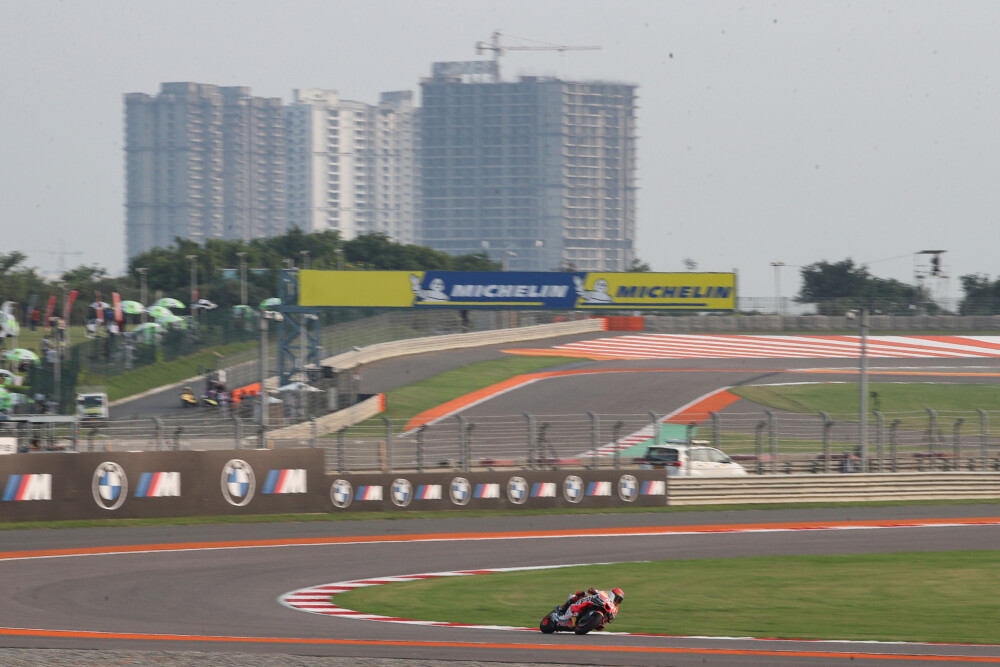Michael Scott | September 27, 2023
Cycle News In The Paddock
COLUMN
Buddh Dodges The Bullet
Has Dorna got away with it again? Writing this after opening practices for first Indian GP, it looks like way. After an increasingly fraught run-up to the latest addition in Dorna’s headlong push towards globalization, the first day proceeded with only one major hitch—an inconsequential 45-minute delay triggered by miscommunication with marshals and officials.
At the outwardly spick-and-span Buddh circuit outside New Delhi, most of the concerns seem to have been put to rest.
If the delay was blamed on the absence of marshals and race officials from their posts—is the worst thing that happens all weekend, it will be a major relief.
 Not without some glitches, the first Indian MotoGP is off to an optimistic start.
Not without some glitches, the first Indian MotoGP is off to an optimistic start.
Teething problems included just getting there.
Two days before practice, Marc Marquez was the highest-profile rider still without a visa, unable to travel. Others, including several team staff and journalists, had been turned away from their scheduled flights because of visa delays.
In the end, all the riders did make it, if (in the case of Marquez, Brad Binder and Jake Dixon) only just.
Something else that was cut very fine was perhaps even more important—the critical process of track homologation, which principally concerns acceptable run-off and other safety provisions. And without which, the riders would not even be able to turn a wheel.
Expansionism gone mad? Two new countries joined the ever-expanding MotoGP calendar in 2023. Kazakhstan didn’t survive long—going the same way as the recently on-then-off Finnish GP, and only partly because of the Ukraine war.
There were days before the event, increasingly urgent questions as to whether India would go the same way.
As we now know, it didn’t. Not very surprising to long-time observers of Dorna’s swaggering brinkmanship and way with the world.
Homologation had been postponed until the very eve of practice, at which point some riders were still expressing concerns about the proximity of walls to some fast corners. A repeat of worries about minimal run-off arose when a video of the track was shown at the preceding (Misano) GP.
The 3.11-mile 13-corner circuit’s original role was to host Formula 1. The car GP lasted only from 2011 to 2013 before it ran out of steam, mired in tax controversy and India’s famous national bureaucratic stasis. The cars had gone, but the walls stayed.
Aside from lingering, if by now milder safety concerns, first impressions of the circuit were highly favorable. Undulations and some corner banking made for a much more interesting and challenging prospect than the circuit map had suggested. There was just the small matter of homologation remaining.
But once everyone had got there, not to mention the fact that tickets had long since sold out, it would have been a brave man to stand up and say: “No homologation. No race.”
The task fell to new FIM Safety Officer Tome Alfonso Ezpeleta. It must have been a nervy first test for Dorna boss Carmelo Ezpeleta’s nephew, who joined Carmelo’s son Carlos and daughter Ana in the upper echelons of Dorna management last year. His appointment to replace the retiring Franco Uncini was immediately under scrutiny, with accusations of nepotism, as Ezpeleta turns MotoGP into a family concern.
The second decision, of course, lay with the riders. They could always have gone on strike.
There is a mixed history here.
Back in 1956, riders in the smaller classes staged a sit-down at Assen, seeking better start money. Multi-champion Geoff Duke lost a chance of a fourth consecutive 500cc crown with Gilera when the FIM suspended him (among others) for supporting the hapless and exploited junior riders.
In 1982 Kenny Roberts and Barry Sheene led a walkout from the French GP at the badly sub-standard Nogaro, which ultimately triggered the birth of IRTA, and a shift in the balance of power, that improved safety as well as riders’ finances.
Next, a mid-race withdrawal by factory riders of a restarted 1989 Italian GP at Misano rendered dangerous by bad weather. Frankie Chili, forced by his Italian sponsors not to join the strike, won and stood on the podium shame-faced and in tears.
The bravest thing Kevin Schwantz ever did off the track was in 1991. Sent to Brazil to assess the Interlagos circuit, he gave it the thumbs down. Much to the dismay of his sponsors Lucky Strike, who were also to sponsor the race. A year later, a less courageous delegation, including ex-teammate Didier de Radigues, reversed the decision. When the riders got there, they came within a hair’s breadth of striking because of the track’s clear and present dangers. The race went ahead, but they never went back.
What if Buddh had turned out to be unacceptable? In the absence of recently deceased IRTA chief and safety guru Mike Trimby, would anyone have had the guts to say so? CN
Click here for all the latest MotoGP news.